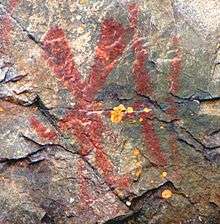Nanabozho
In Anishinaabe aadizookaan (traditional storytelling), particularly among the Ojibwe, Nanabozho ([nɐˌnɐbʊˈʒʊ]), also known as Nanabush,[1] is a spirit, and figures prominently in their storytelling, including the story of the world's creation. Nanabozho is the Ojibwe trickster figure and culture hero (these two archetypes are often combined into a single figure in First Nations mythologies, among others).

Similar characters in other cultures
Among the eastern Algonquian peoples located north of the Abenaki areas, a similar character to Nanabozho existed called Tcakabesh in the Algonquin language, Chikapash among the eastern James Bay Crees, Chaakaapaas by the Naskapi, Tshakapesh in the Innu language and Tcikapec in Atikamekw language, changing to various animal forms to various human forms (adult to child) and to various mythical animals such as the Great Porcupine, or Big Skunk. He conquered or diminished these mythical animals to smaller size after killing or changing them with his trickery or shapeshifting. Among the Meskwaki, Wīsakehā serves a similar role, as does Wisakedjak among northern Algonquian peoples and for the Saulteaux in the Great Plains. The Abenaki-influenced Algonquin had a similar figure called Kanòjigàbe (Fiero spelling: Ganoozhigaabe; Abenaki Gluskabe).
Nanabozho name variations
The Nanabozho name varies in the Ojibwe language depending on whether it is presented with a first-person prefix n- (i.e. Nanabozho), third-person prefix w- (i.e. Wanabozho), or null-person prefix m- (i.e. Manabozho); the "Manabozho" form of the name is most commonly associated with Menominee language version of these stories. In addition, depending on the story and the narrator's role in telling the story, the name may be presented in its regular nominative form (with the final o, i.e. Nanabozho) or in its vocative form (without the final o, i.e. Nanabozh). Due to the way the two o sounds, they are often each realized as oo (i.e. Nanaboozhoo). In some dialects, zh is realized as z. These variations allow for associating the name with the word for "rabbit(-)" (waabooz(o-)).
Due to the placement of word stress, determined by metrical rules that define a characteristic iambic metrical foot, in which a weak syllable is followed by a strong syllable, in some dialects the weak syllable may be reduced to a schwa, which may be recorded as either i or e (e.g. Winabozho or Wenabozho if the first weak syllable is graphically shown, Nanabizho if the second weak syllable is graphically shown).
In addition, though the Fiero double-vowel system uses zh, the same sound in other orthographies can be realized as j in the Algonquin system or š (or sh) in the Saulteaux-Cree system (e.g. Nanabozho v. Nanabojo). To this mix, depending on if the transcriber used French or English, the Anishinaabe name may be transcribed to fit the phonetic patterns of one of the two said languages (e.g. "Winnaboujou" and "Nanabijou": French rendering of Winabozho and Nanabizho respectively, or "Nanabush": English rendering of Nanabozh).
Stories

Nanabozho is one of four sons from what Europeans will interpret as spirits of directions.[2] He has a human mother, and E-bangishimog ("In the West"), a spirit father.
Nanabozho most often appears in the shape of a rabbit and is characterized as a trickster. In his rabbit form, he is called Mishaabooz ("Great rabbit" or "Hare") or Gitchii-waabooz ("Big rabbit"). He was sent to Earth by Gitche Manitou to teach the Ojibwe. One of his first tasks was to name all the plants and animals. Nanabozho is considered to be the founder of Midewiwin. He is the inventor of fishing and hieroglyphs. This historical figure is a shapeshifter and a co-creator of the world.[3][4]
Henry Wadsworth Longfellow's epic poem, The Song of Hiawatha is an outsider retelling of several Nanabozho stories based on research conducted by Henry Rowe Schoolcraft.
Mishaabooz name variations
Like the transcription variations found among "Nanabozho," often Mishaabooz is transcribed into French as Michabous and represented in English as Michabou. Additional name variations include:
"Winneboujou, Winabojo, Wenabozho, Wenaboozhoo, Waynaboozhoo, Wenebojo, Nanaboozhoo, Nanabojo, Nanabushu, Nanabush, Nanapush, Nenabush, Nenabozho, Nanabosho, Manabush, Manabozho, Manibozho, Nanahboozho, Minabozho, Manabus, Manibush, Manabozh, Manabozo, Manabozho, Manabusch, Manabush, Manabus, Menabosho, Nanaboojoo, Nanaboozhoo, Nanaboso, Nanabosho, Nenabuc, Amenapush, Ne-Naw-bo-zhoo, Kwi-wi-sens Nenaw-bo-zhoo [...] Michabo, Michabou, Michabous, Michaboo, Mishabo, Michabo, Misabos, Misabooz, Messou" [5]
Notes
- Legendary Native American Figures: Nanabozho (Nanabush)
- He is descended from a human mother, and his father spiritually impregnated a mother like the virgin birth of Jesus and other gods and heroes cross-culturally. The Anishinaabeg say the mother's name means "nourishment", but Henry Schoolcraft suggests the name is from the Dakota Winona ("first-born daughter").
- "The Great Hare". Community-2.webtv.net. Archived from the original on 2012-12-09. Retrieved 2010-06-29.
- "Nanabozho, Access genealogy". Accessgenealogy.com. Retrieved 2010-06-29.
- http://www.native-languages.org/nanabozho.htm
References
- Benton-Banai, Edward. The Mishomis Book: The Voice of the Ojibway. Hayward, WI: Indian Country Communications, 1988.
- Chamberlain, A. F. "Nanibozhu amongst the Otchipwe, Mississagas, and other Algonkian tribes," Journal of American Folklore 4 (1891): 193-213.
- Johnston, Basil. Ojibway Heritage. Toronto: McClelland and Stewart, 1976.
- Barnouw, Victor. Wisconsin Chippewa Myths and Tales. Madison: University of Wisconsin Press, 1977.
- Webkamigad, Howard. Ottawa Stories from the Springs. East Lansing: Michigan State University Press, 2015.
External links
- "Manabosho's Hieroglyphics" recorded by Seth Eastman at Northern Illinois University
- "Nanabozo" in The Canadian Encyclopedia
- "Nanabozho" in Handbook of American Indians North of Mexico, 1907. Reproduced in Handbook of Indians of Canada, 1913.
- How Nanabush Created the World
- Nanabush and the Giant Beaver
- The Legend of 'Nanabozho' (from the CBC radio archives, as an audio file)
- Native American: North Gods: Algonquin
- Nanabozho, Access genealogy.